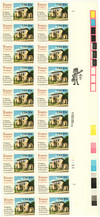
# 2017 - 1982 20c Touro Synagogue
U.S. #2017
1982 20¢ Touro Synagogue
- Stamp honors the oldest standing synagogue in the US
- Issued for the 250th anniversary of George Washington’s birth
- Includes quote from Washington’s speech when he visited in 1790
Stamp Category: Commemorative
Value: 20¢, first-class rate
First Day of Issue: August 22, 1982
First Day City: Newport, Rhode Island
Quantity Issued: 110,130,000
Printed by: Bureau of Engraving and Printing
Printing Method: Photogravure and engraved
Format: Panes of 50 in sheets of 200
Perforations: 11
Why the stamp was issued: To honor the oldest standing synagogue in the US. Issued in 1982 to celebrate George Washington’s 250th birthday, a tribute to the president who visited the synagogue in 1790.
About the stamp design: Donald Moss created the painting of the synagogue for the stamp, which takes up the right two-thirds of the design. Bradbury Thompson did the typography on the left side of the stamp. In addition to the name of the synagogue, its location, and year, the design includes lines from a speech George Washington gave when he visited Newport in 1790. It reads, “To bigotry, no sanction. To persecution, no assistance.”
About the printing process: This was the first stamp in which both the intaglio and gravure parts of the combination press were used together to print one stamp.
First Day City: The First Day ceremony for this stamp was held at the Touro Synagogue in Newport, Rhode Island.
Unusual fact about this stamp: Imperforate errors exist.
History the stamp represents: On December 2, 1763, the Touro Synagogue was officially dedicated after four years of construction.
In the 1620s, Jewish settlers of Spanish and Portuguese origin fled their homes in Amsterdam and London in search of religious freedom. Over the years they traveled from Brazil to the Caribbean, particularly to Barbados. Then in the spring of 1658, fifteen Spanish/Portuguese Jewish families arrived in Newport, Rhode Island. They believed they would be able to practice their faith under the law of Governor Roger Williams. Williams established the Colony of Rhode Island and Providence Plantations on the basis of freedom of religion and conscience. This congregation was known as Nephuse Israel (Scattered of Israel).
For 100 years, this small congregation worshiped in private homes. Then in 1758, the congregation had grown in size so as to require a synagogue. Cantor Isaac Touro led the campaign to establish a synagogue. After soliciting funds from other congregations as far away as London, Jamaica, and Suriname, land was purchased in 1759. Construction began soon after with local philanthropist Aaron Lopez laying the corner stone. The renowned architect Peter Harrison, who may have donated his work, designed the synagogue. Inside, the synagogue had 12 Ionic columns, representing the 12 tribes of ancient Israel, each carved from a single tree. The structure was also built to face east toward Jerusalem.
Once completed, the synagogue was dedicated on December 2, 1763, during that year’s Hanukkah festival celebrations. Many people outside of the congregation came to celebrate the synagogue’s opening. These included clergy and dignitaries from around the colony, including Congregationalist Minister Ezra Stiles (future president of Yale University).
During the American Revolution, many of the town’s Jewish residents fled the city when the British occupied it. Isaac Touro remained to keep watch over the synagogue. The British used it as a hospital and assembly hall. Although they needed wood for burning during the winter, the synagogue’s importance as a hospital spared it from being destroyed. After the British left, the Jewish families began to return.
In 1790, the congregation’s president, Mendes Seixas, sent President George Washington a letter expressing his support for his administration. He also shared his ideas about the importance of religious liberties and the separation of church and state in the new nation.
President Washington responded in part, “The Government of the United States … gives to bigotry no sanction, to persecution no assistance… May the children of the Stock of Abraham, who dwell in this land, continue to merit and enjoy the good will of the other Inhabitants; while every one shall sit in safety under his own vine and fig tree, and there shall be none to make him afraid. May the father of all mercies scatter light and not darkness in our paths, and make us all in our several vocations useful here, and in his own due time and way everlastingly happy.” In the years since, the synagogue has held an annual reading of Washington’s letter. Read the full text of Washington’s letter here.
Over the years, the congregation dispersed and the synagogue closed. In July 1852, famed poet Henry Wadsworth Longfellow visited the synagogue and its cemetery. He was so moved by the experience, he penned a popular poem, “The Jewish Cemetery at Newport,” which you can read here.
Two years later, Judah Touro, son of the synagogue’s namesake, left a bequest for its restoration. By the 1880s, new Jewish families arrived from Europe and reopened the synagogue.
In 1946, the Touro Synagogue was made a National Historic Site. Today, it’s the oldest standing synagogue in the US.
U.S. #2017
1982 20¢ Touro Synagogue
- Stamp honors the oldest standing synagogue in the US
- Issued for the 250th anniversary of George Washington’s birth
- Includes quote from Washington’s speech when he visited in 1790
Stamp Category: Commemorative
Value: 20¢, first-class rate
First Day of Issue: August 22, 1982
First Day City: Newport, Rhode Island
Quantity Issued: 110,130,000
Printed by: Bureau of Engraving and Printing
Printing Method: Photogravure and engraved
Format: Panes of 50 in sheets of 200
Perforations: 11
Why the stamp was issued: To honor the oldest standing synagogue in the US. Issued in 1982 to celebrate George Washington’s 250th birthday, a tribute to the president who visited the synagogue in 1790.
About the stamp design: Donald Moss created the painting of the synagogue for the stamp, which takes up the right two-thirds of the design. Bradbury Thompson did the typography on the left side of the stamp. In addition to the name of the synagogue, its location, and year, the design includes lines from a speech George Washington gave when he visited Newport in 1790. It reads, “To bigotry, no sanction. To persecution, no assistance.”
About the printing process: This was the first stamp in which both the intaglio and gravure parts of the combination press were used together to print one stamp.
First Day City: The First Day ceremony for this stamp was held at the Touro Synagogue in Newport, Rhode Island.
Unusual fact about this stamp: Imperforate errors exist.
History the stamp represents: On December 2, 1763, the Touro Synagogue was officially dedicated after four years of construction.
In the 1620s, Jewish settlers of Spanish and Portuguese origin fled their homes in Amsterdam and London in search of religious freedom. Over the years they traveled from Brazil to the Caribbean, particularly to Barbados. Then in the spring of 1658, fifteen Spanish/Portuguese Jewish families arrived in Newport, Rhode Island. They believed they would be able to practice their faith under the law of Governor Roger Williams. Williams established the Colony of Rhode Island and Providence Plantations on the basis of freedom of religion and conscience. This congregation was known as Nephuse Israel (Scattered of Israel).
For 100 years, this small congregation worshiped in private homes. Then in 1758, the congregation had grown in size so as to require a synagogue. Cantor Isaac Touro led the campaign to establish a synagogue. After soliciting funds from other congregations as far away as London, Jamaica, and Suriname, land was purchased in 1759. Construction began soon after with local philanthropist Aaron Lopez laying the corner stone. The renowned architect Peter Harrison, who may have donated his work, designed the synagogue. Inside, the synagogue had 12 Ionic columns, representing the 12 tribes of ancient Israel, each carved from a single tree. The structure was also built to face east toward Jerusalem.
Once completed, the synagogue was dedicated on December 2, 1763, during that year’s Hanukkah festival celebrations. Many people outside of the congregation came to celebrate the synagogue’s opening. These included clergy and dignitaries from around the colony, including Congregationalist Minister Ezra Stiles (future president of Yale University).
During the American Revolution, many of the town’s Jewish residents fled the city when the British occupied it. Isaac Touro remained to keep watch over the synagogue. The British used it as a hospital and assembly hall. Although they needed wood for burning during the winter, the synagogue’s importance as a hospital spared it from being destroyed. After the British left, the Jewish families began to return.
In 1790, the congregation’s president, Mendes Seixas, sent President George Washington a letter expressing his support for his administration. He also shared his ideas about the importance of religious liberties and the separation of church and state in the new nation.
President Washington responded in part, “The Government of the United States … gives to bigotry no sanction, to persecution no assistance… May the children of the Stock of Abraham, who dwell in this land, continue to merit and enjoy the good will of the other Inhabitants; while every one shall sit in safety under his own vine and fig tree, and there shall be none to make him afraid. May the father of all mercies scatter light and not darkness in our paths, and make us all in our several vocations useful here, and in his own due time and way everlastingly happy.” In the years since, the synagogue has held an annual reading of Washington’s letter. Read the full text of Washington’s letter here.
Over the years, the congregation dispersed and the synagogue closed. In July 1852, famed poet Henry Wadsworth Longfellow visited the synagogue and its cemetery. He was so moved by the experience, he penned a popular poem, “The Jewish Cemetery at Newport,” which you can read here.
Two years later, Judah Touro, son of the synagogue’s namesake, left a bequest for its restoration. By the 1880s, new Jewish families arrived from Europe and reopened the synagogue.
In 1946, the Touro Synagogue was made a National Historic Site. Today, it’s the oldest standing synagogue in the US.










